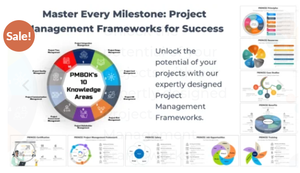MyWorldGo
Understanding Project Management Frameworks
Blog Information
- Posted By : Ppt infographics
- Posted On : Jun 22, 2024
- Views : 158
- Category : General
- Description : Welcome to pptinfographics, your comprehensive resource for Project Management Frameworks. Our collection covers a range of frameworks, including traditional methodologies like Waterfall and modern approaches like Agile and Scrum. These infographics provide an overview of each framework's principles, processes, and best practices, making it easy to understand and apply them in your projects. Whether you're new to project management or looking to enhance your skills, our infographics offer valuable insights and guidance. Elevate your project management knowledge with our visually appealing and informative frameworks. Visit pptinfographics today and explore the world of project management methodologies!
- Location : Lucknow, Uttar Pradesh, India
Overview
-
Project management frameworks are essential tools that help organizations effectively plan, execute, and manage projects of various sizes and complexities. These frameworks provide a structured approach to project management, offering guidelines, processes, and best practices to ensure successful project outcomes. Let's explore some popular project management frameworks that are widely used across industries.1. Waterfall ModelThe Waterfall model is one of the oldest and most straightforward project management frameworks. It follows a linear and sequential approach, where each phase of the project must be completed before moving on to the next. The phases typically include requirements gathering, design, implementation, testing, and maintenance. While this model is easy to understand and implement, it lacks flexibility, making it less suitable for projects with changing requirements.2. Agile MethodologyAgile is a flexible and iterative approach to project management, focusing on delivering value to customers through incremental improvements. It emphasizes collaboration, continuous improvement, and the ability to adapt to change. Agile frameworks, such as Scrum and Kanban, break the project into smaller iterations or sprints, allowing for regular feedback and adjustments. This approach is particularly effective for projects where requirements are likely to change.3. Scrum FrameworkScrum is a popular Agile framework that emphasizes teamwork, accountability, and iterative progress toward a well-defined goal. In Scrum, the project is divided into short iterations called sprints, usually lasting two to four weeks. At the beginning of each sprint, the team plans the work to be done and meets daily to discuss progress and challenges. At the end of the sprint, the team reviews the work completed and adjusts the project plan as necessary.4. Kanban MethodKanban is another Agile framework that focuses on visualizing work, limiting work in progress, and maximizing efficiency. Kanban uses a board with columns representing different stages of the project, such as To Do, In Progress, and Done. Team members move tasks across the board as they progress, ensuring a steady flow of work. Kanban is particularly useful for teams that need to manage multiple projects simultaneously.5. Lean Project ManagementLean project management is based on the principles of Lean manufacturing, aiming to eliminate waste and maximize value for the customer. It focuses on delivering the highest quality product with the fewest resources and in the shortest amount of time. Lean project management emphasizes continuous improvement and customer feedback, making it well-suited for projects where efficiency and speed are critical.ConclusionProject management frameworks provide a structured approach to managing projects, offering guidelines and best practices to ensure successful outcomes. Whether you choose the Waterfall model for its simplicity, Agile for its flexibility, or Lean for its efficiency, selecting the right framework depends on your project's specific requirements and goals. By understanding and applying these frameworks, you can improve your project management practices and increase the likelihood of project success.
